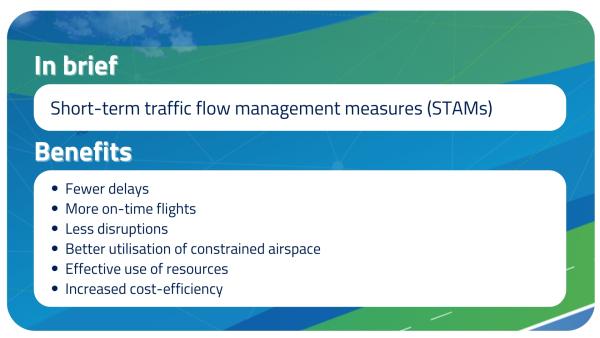Short-term air traffic flow capacity measures help ATM respond to imbalances in operational demand
With a focus on individual flights, SESAR’s flexible air traffic flow management measures help prevent bottlenecks in the sky.
Aviation networks are vulnerable to sudden and unexpected changes in air traffic demand and capacity. Solutions developed by SESAR, when applied to individual or small groups of flights, help air traffic control maintain smooth operations – even in turbulent times.

Weather, technical issues and unforeseen events can cause the balance between air traffic demand and ATM capacity to change in an instant. Effectively responding to these unexpected changes requires flexible solutions like short-term traffic flow management measures (STAMs).
A portfolio of tools, STAMs provide air traffic controllers with the flexibility they need to respond to imbalances in operational demand. These tools can include everything from interventions at the local level (e.g., temporarily constraining a flight or group of flights at a lower altitude), minor re-routing or minor changes to aircraft take-off times.
When applied to a limited number of flights, STAMs reduce traffic peaks and network congestion. In doing so, they help minimise overall delays and make the best short-term use of airspace resources (typically within a few hours).
SESAR has played a central role in developing STAMs, providing technological advancements in digital tools and facilitating information sharing to deliver efficient, flexible and effective air traffic flow management solutions.
The solution
SESAR Solution #17, ‘Advanced short-term ATFCM measures (STAMs)’, includes a set of digital support tools. When used at the network level, these tools detect hotspots and disseminate the information to flow management positions in the area control centres. The toolset also includes ‘what-if’ functionalities that allow users to evaluate the impact STAMs will have before they are applied(1).
The shared information takes into account an expanded dataset that includes weather, airport operations, runway occupancy and traffic complexity. The data is shared digitally by EUROCONTROL Network Manager tools and has the possibility to use business-to-business (B2B) system-wide information management (SWIM).
The results
Because STAMs helps air traffic management reduce overall delays, its use can result in more on-time flights and less disruptions for passengers. Furthermore, STAMs allow for a better utilisation of constrained airspace and airport capacity, thus ensuring the best use of available resources and increased cost efficiency. The measures also provide a flexible approach to traffic management, allowing for timely adjustments in response to changing conditions.
The details
- By supporting collaboration between the EUROCONTROL Network Manager, airlines, airports and flow management positions, SESAR STAMs ensure that these stakeholders can implement the relevant measures in a coordinated and smooth manner.
- SESAR deployment encouraged air navigation service providers (ANSPs) to connect their local flow management position tools to the EUROCONTROL Network Manager using the delivered SWIM services.
- Through the STAM, STAM Phase 2 and network collaborative management projects (#78AF4 ATFCM measures (STAM), 2015_110_AF4 STAM Phase 2 (NM) and 2017_054_AF4 Network Collaborative Management), the EUROCONTROL Network Manager delivered a complete package of system support and operational procedures that enable the harmonised and effective deployment of STAM (phase 2) throughout European airspace.
In action
The SESAR STAM solution is already part of synchronised implementation plans across Europe. For example, ANSPs in Italy (ENAV) (2) and France (DSNA) (3) have implemented enhanced STAM projects.
In the Netherlands, LVNL, the Dutch ANSP, introduced a workload model for the Amsterdam area control and approach control operations to support the use of STAM and the flexible use of airspace (FUA)(4).
Finally, German ANSP Deutsche Flugsicherung implemented the AIRMAGIC traffic complexity tool at the Munich ACC. This tool generates real-time traffic predictions and analyses based on quick-time simulations.
References
- Sol17 01 CN Solution 17 Advanced STAM.pdf
- Projects - ENAV Deployment of traffic complexity tool and STAM phase 2 | SESAR DM
- Projects - Enablers of Network Collaborative Management for En Route and Airports at DSNA | SESAR DM
- Projects - Workload model for Amsterdam Area Control and Approach Control operations | SESAR DM

